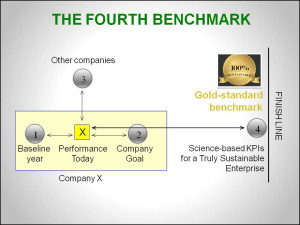The Fourth ESG Benchmark

When organizations assess how well a company is doing on its sustainability efforts, they need something to compare it to: they need a benchmark. Today, raters and rankers of companies’ sustainability progress use three benchmarks to assess company performance on environmental, social, and governance (ESG) factors. These benchmarks are also used by companies themselves in their sustainability reports.
1. ESG performance in a baseline year
The company compares its performance today on an environmental or social issue to its performance on that issue in a previous year. Progress is expressed as a percent improvement, or is plotted against several previous years to show a trend line.
2. ESG performance goal in a future year
The firm compares its performance today on an environmental or social issue to a performance goal for that issue in a future year. There may be several future goals, such as five-year goals or ten-year goals, or a 2020 goal and a 2050 goal as is common for greenhouse gas emissions.
3. Other company ESG performance
The enterprise compares its performance today on an environmental or social issue to the performance of other companies on that issue. The external baseline could be the performance of a specific company, an average performance of other companies in the firm’s sector, or an average of all companies under consideration. This approach is most commonly used when rating and ranking companies on their ESG performance.
The above three benchmarks for ESG progress are deceptive. The unintended consequences of their use may be celebration of laggards who easily make big incremental improvements because they were so far behind; celebration of companies with anemic goals; or celebration of the best of a bad lot. Following Stephen Covey’s advice, let’s begin with the end in mind and continue the above list with a fourth benchmark.
4. Gold-standard ESG performance
The company’s performance is compared with how it would perform if it were a truly sustainable enterprise—one that creates positive environmental, social, and economic value. This benchmark puts a stake in the ground and declares the characteristics of a truly sustainable enterprise.
It is the “gold-standard” yardstick against which company ESG performance is compared. It is based on what the best scientific minds declare as the performance criteria for a thriving enterprise that would win a gold medal for its contribution to a sustainable society and a sustainable environment.
Isn’t it time that we stopped steering by looking in the rear-view mirror, or by using a GPS that just shows us the next checkpoint on our journey, or by just making sure that we are making better time than others on the road? Shouldn’t we judge our progress by how much closer we are to our destination of being a truly sustainable enterprise, as described by a fourth gold-standard ESG benchmark?
As usual, the above slides are from my Master Slide Set.
Please feel free to add your comments and questions using the Comment link below. For email subscribers, please click here to visit my site and provide feedback.
Bob





Comments are closed.